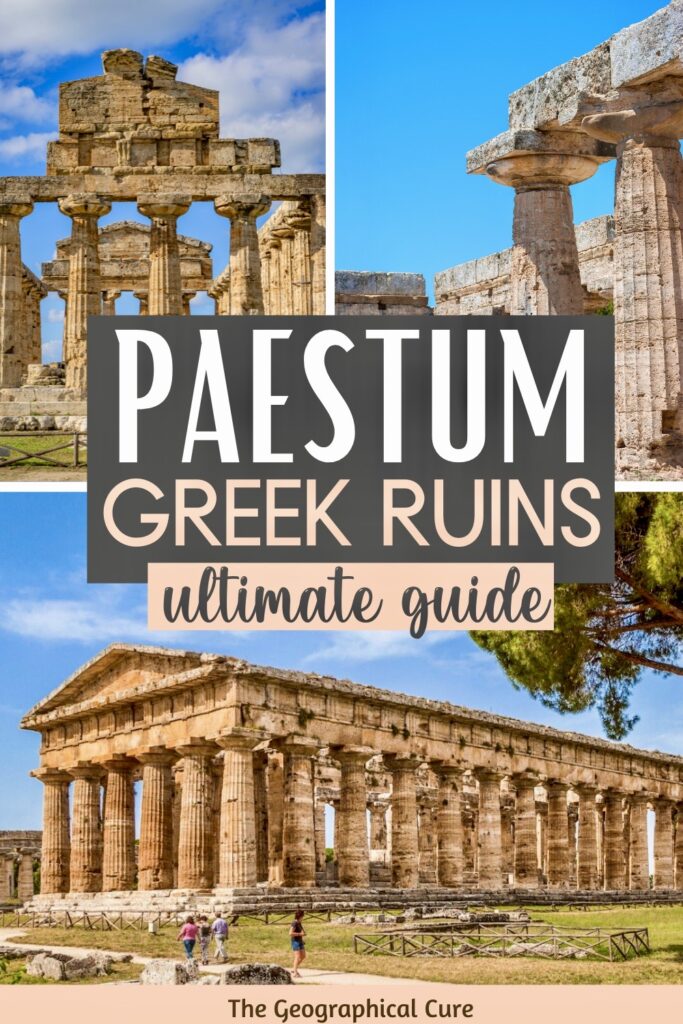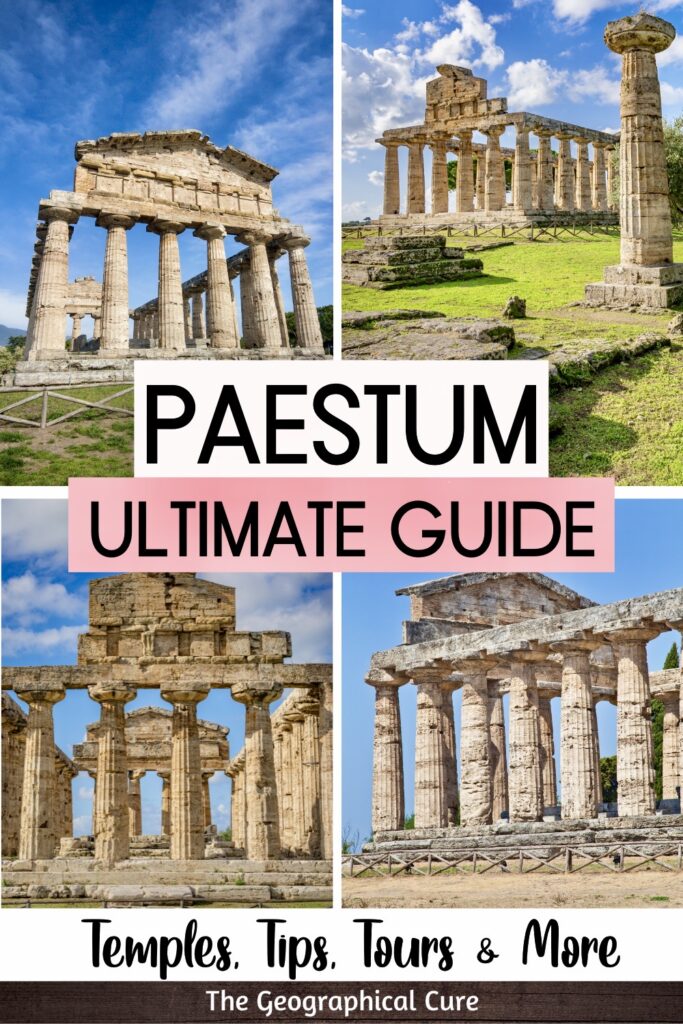Tucked away just south of the renowned Amalfi Coast lies the town of Paestum, a vivid testament to Italy’s ancient history. If you’re gearing up for a visit, this is the ultimate guide to experiencing Paestum’s Greek and Roman wonders.
This comprehensive overview takes you on a journey through the archaeological site, highlighting all the captivating sights awaiting your exploration.
The UNESCO-listed Paestum stands as a veritable treasure trove of awe-inspiring Greek archaeological marvels, the finest on the Italian mainland.
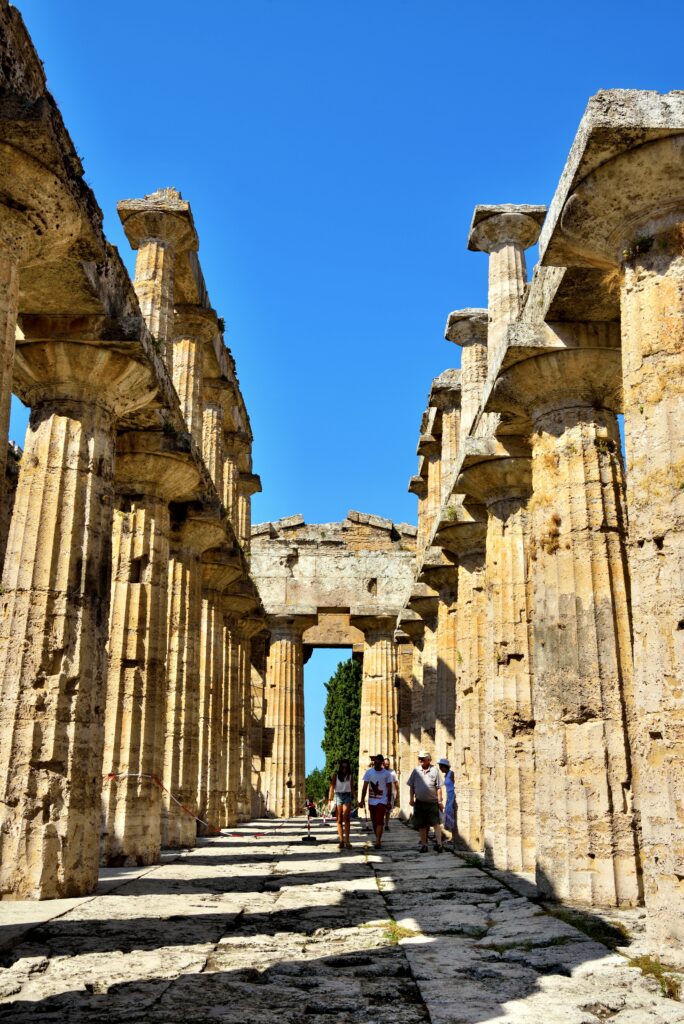
The site is only surpassed by the superb Valley of the Temples in Agrigento Sicily. But Paestum offers a more condensed and accessible experience.
>>> Click here to pre-book a Paestum ticket
What Is Paestum: A Short History
Paestum was once a vital part of Magna Graecia, or Greater Greece. It proudly showcases three exceptionally preserved Doric temples that harken back to the years 650 to 450 BC.
In the 6th century BC, the Greeks colonized the southern part of Italy, including Campania, Sicily, and Calabria. Around 600 BC, Poseidonia was established and named after the Greek god of the sea.
Paestum flourished as a Greek city, featuring an agora, roads, and splendid temples.
In the 5th century BC, the indigenous Lucanians took possession of the city. They renamed it Paestum.
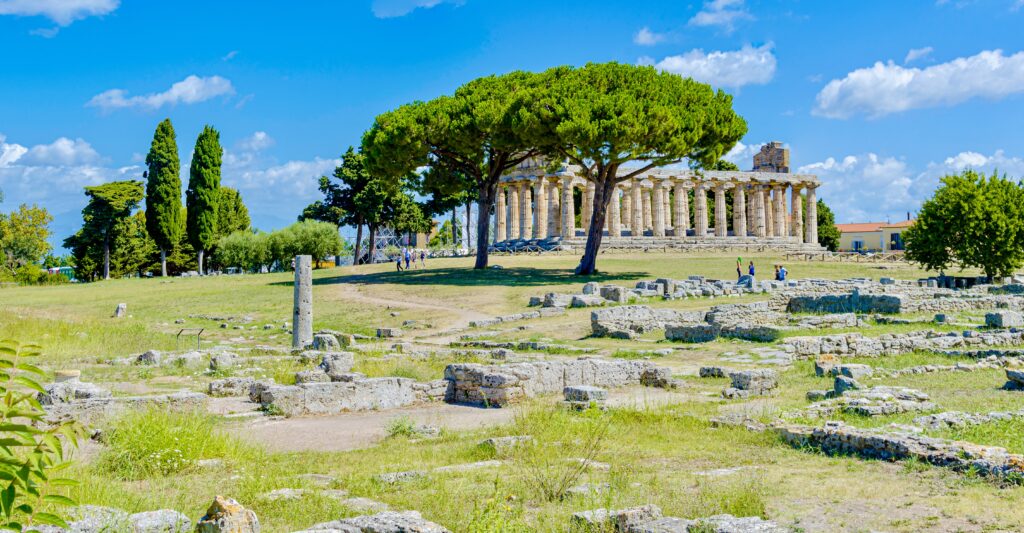
With the Pyrrhic War, Rome conquered Paestum. It was transformed into a Roman city in 273 BC. Roman structures were erected atop some Greek sites, like the Roman amphitheater and forum.
During the Middle Ages, Paestum faced a decline and eventual abandonment. The fall of the Western Roman Empire, political instability, changing trade routes, the plague, and the gradual shift of power to other regions all played a part in diminishing Paestum’s significance.
However, after centuries of oblivion, Paestum was rediscovered in the 18th century. This was about when Pompeii was unearthed and excavated as well.
In 1998, Paestum was recognized as a UNESCO World Heritage Site.
Today, Paestum boasts three remarkably preserved Greek temples, an amphitheater, forum, houses, and ancient roads. It’s a captivating journey through the ancient past!
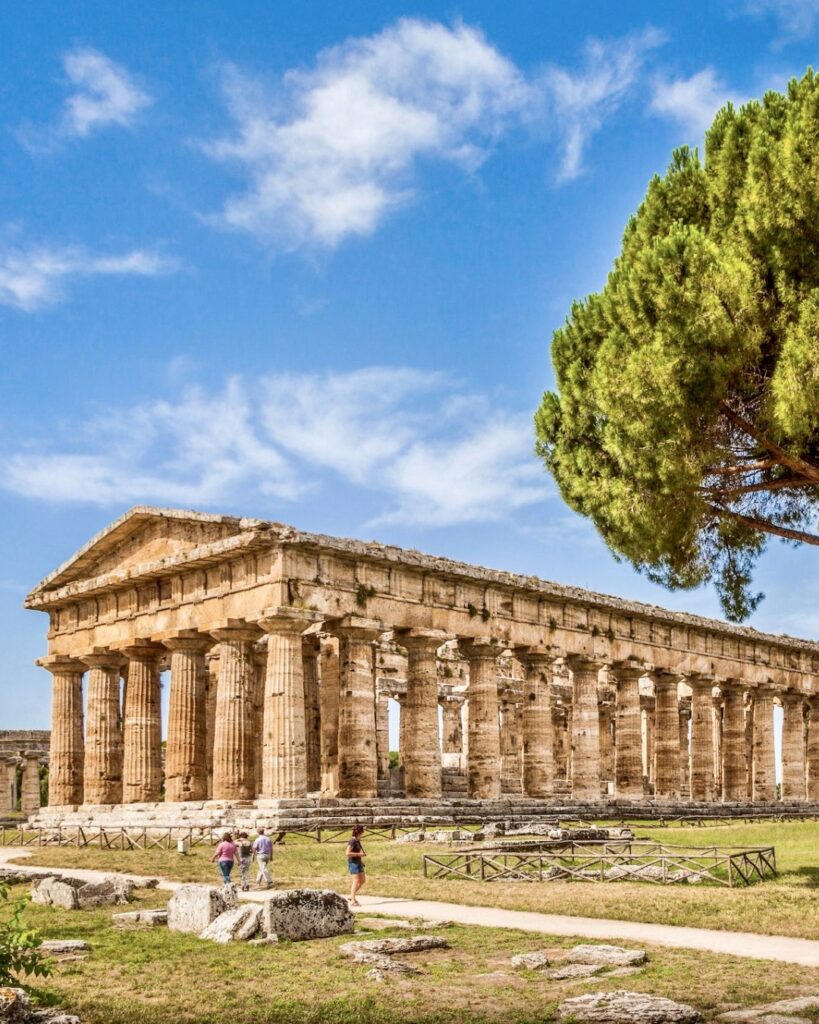
Guide To Paestum: What To See
Begin your visit at the visitor center, where you can obtain maps, information, and any necessary tickets.
Much of the forum and other parts of town are in ruins. But there are three absolutely magnificent temples and a first rate museum. Via Sacre runs the length of the site and connects the temples.
If you are a history buff, you may want to book a guided tour with an archaeologist or a 2 hour private tour.
Here’s a rundown of what you can see on a visit to Paestum.
1. Temple of Neptune (Poseidon)
As you step into the park, you’ll be greeted by the majestic Temple of Neptune, also known as the Temple of Poseidon or the Temple of Hera II.
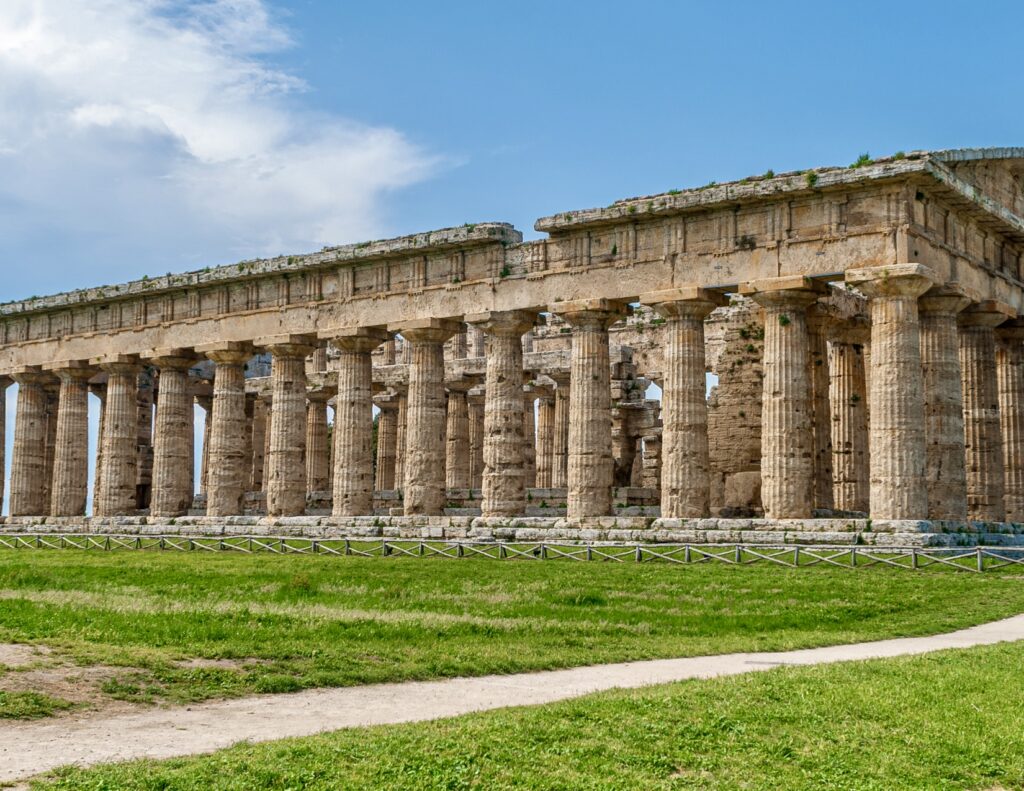
Among Paestum’s treasures, this is the youngest and best preserved of the set of temples from Magna Graecia. It’s akin to the Parthenon in Athens.
Erected in 450 BC, it stands as a textbook example of Doric architecture, capturing the essence of Italy and Greece. It’s lined in travertine stone that appears gold when the sun shines on it.
The temple stands on a high platform with six columns on the front and back, and fourteen columns on the sides. It’s known for its elegant proportions and intricate details.
The imposing columns appear lighter than they are due to the grooves carved into the shafts. The intent was to play with light and shadow and give the effect of the folds of a peplos, a traditional Greek dress.
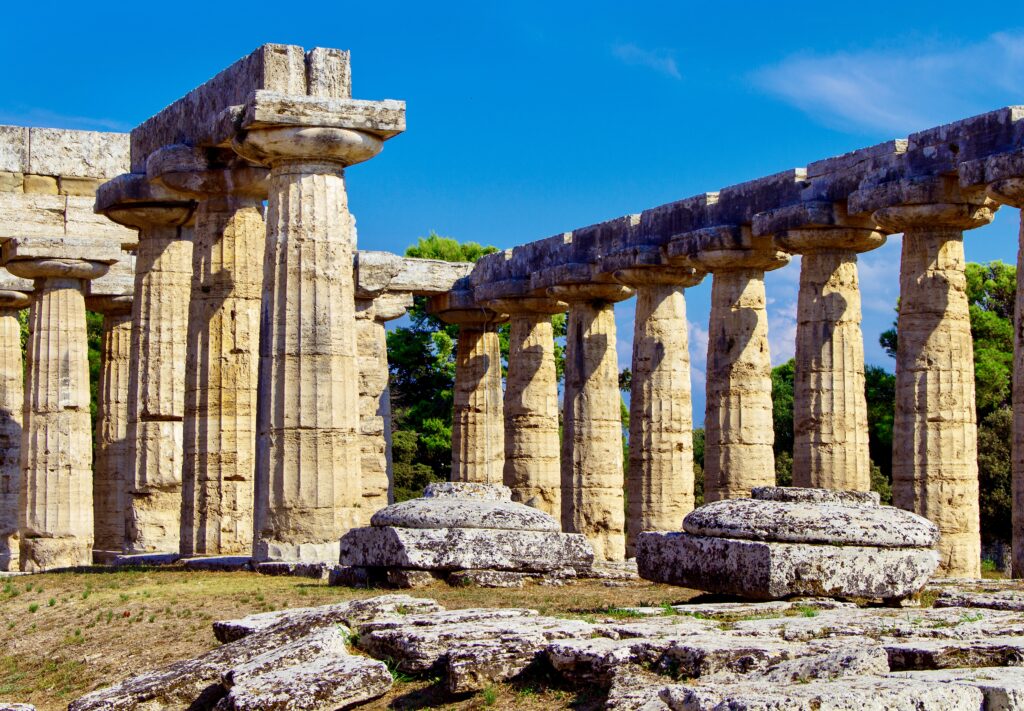
The temple’s entablature and pediments have survived nearly intact. The frieze once consisted of triglyphs and uncured metopes. Only the roof and internal walls of the cella are missing.
The cella once held a statue of the god Neptune.
In the past, scholars believed that the temple was dedicated to Neptune/Poseidon. But recent studies propose that it might have been built to honor Apollo instead.
Visitor can access the temple’s interior, although entry is limited to a small group at a time. So, a short wait in line might be required. But it’s well worth it.
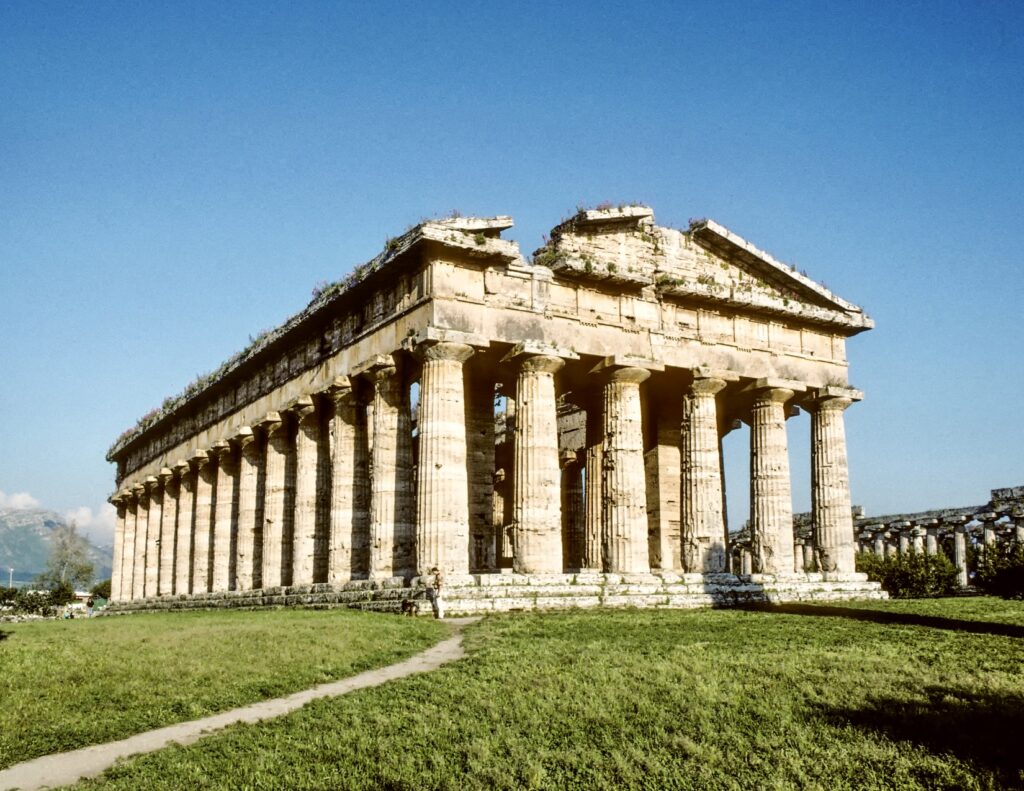
2. Temple of Hera
Built around 550 B.C., the Temple of Hera I is the oldest and smallest of the temples.
It was once known as the “Basilica,” after it was misidentified by 18th century archaeologists. They mistakenly thought the lack of pediments meant that it had a civic function.
But the discovery of ex-votos and inscriptions allowed the temple to be rightfully restored to its association with ancient Greek goddess Hera, wife and sister of Zeus. She was considered the queen of the gods and the goddess of marriage and childbirth.
The delicate temple stands on a high podium with six columns on the front and back, and thirteen columns on the sides. It’s a bit wider than most Greek temples.
A statue of the Zeus has been reconstructed from fragments found between the Temple of Neptune and the Temple of Hera. It’s in the archaeological museum.
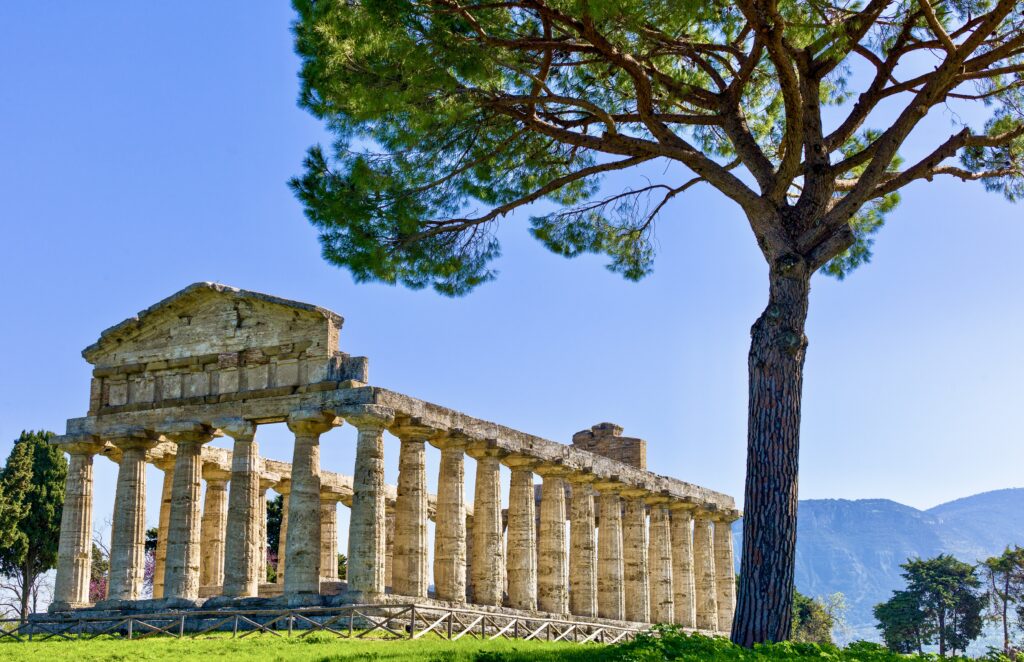
3. Temple of Athena
Constructed around 500 BC, during the zenith of Greek influence, the Temple of Athena is crafted from local limestone. It features the characteristic attributes of the Doric order, including unadorned columns with plain capitals.
The temple’s design is peripteral, enveloped by a colonnade of Doric columns that contribute to its harmonious proportions.
The temple was dedicated to the goddess Athena. She symbolized wisdom, courage, and strategic warfare in Greek mythology. It served as a center of devotion and offerings to seek the blessings of the revered deity.
The temple’s dimensions measure approximately 80 feet by 200 feet. It features a facade adorned with nine columns and eighteen columns on the sides.
Unlike the Neptune and Hera temples, you cannot go inside this one.
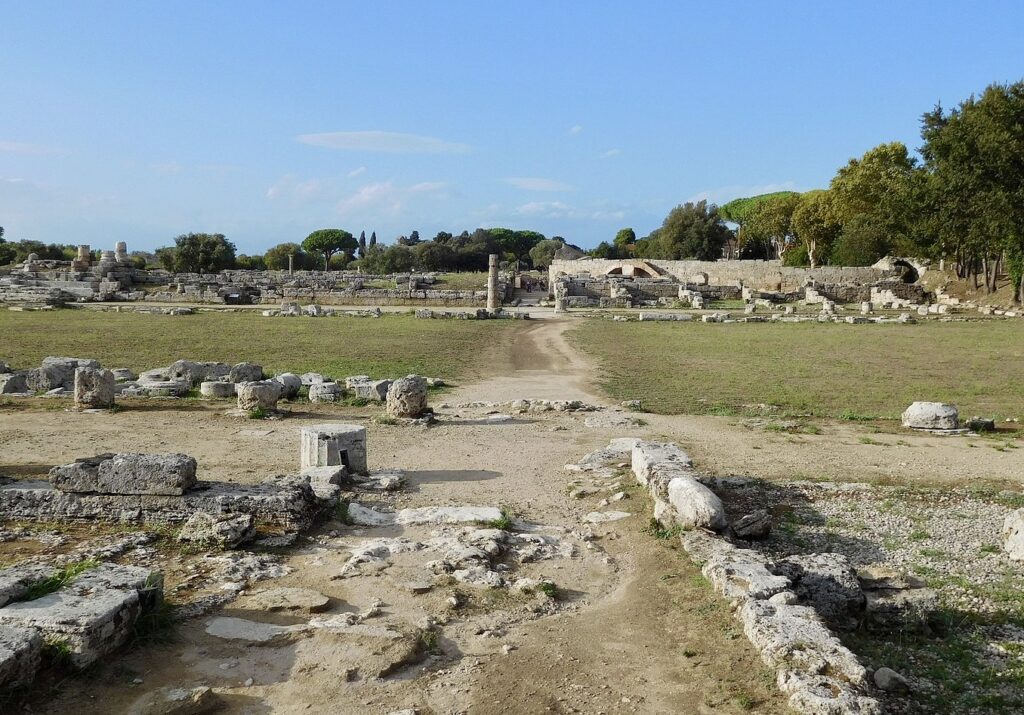
4. Roman Forum
In Roman cities, the forum was the heart of city life. The forum in Paestum was no different. And it’s in the central part of the complex.
In its present guise, the forum is the result of a layout carried out when Emperor Augustus ruled. The colonnades surrounding the square were built and the floor level was lowered.
The area was surrounded on all sides by tabernae (shops) and a macellum (covered market).
You can also make out traces of public buildings like the basilica, small shrines, and a city archive. Some of the shops even retain their original flooring.
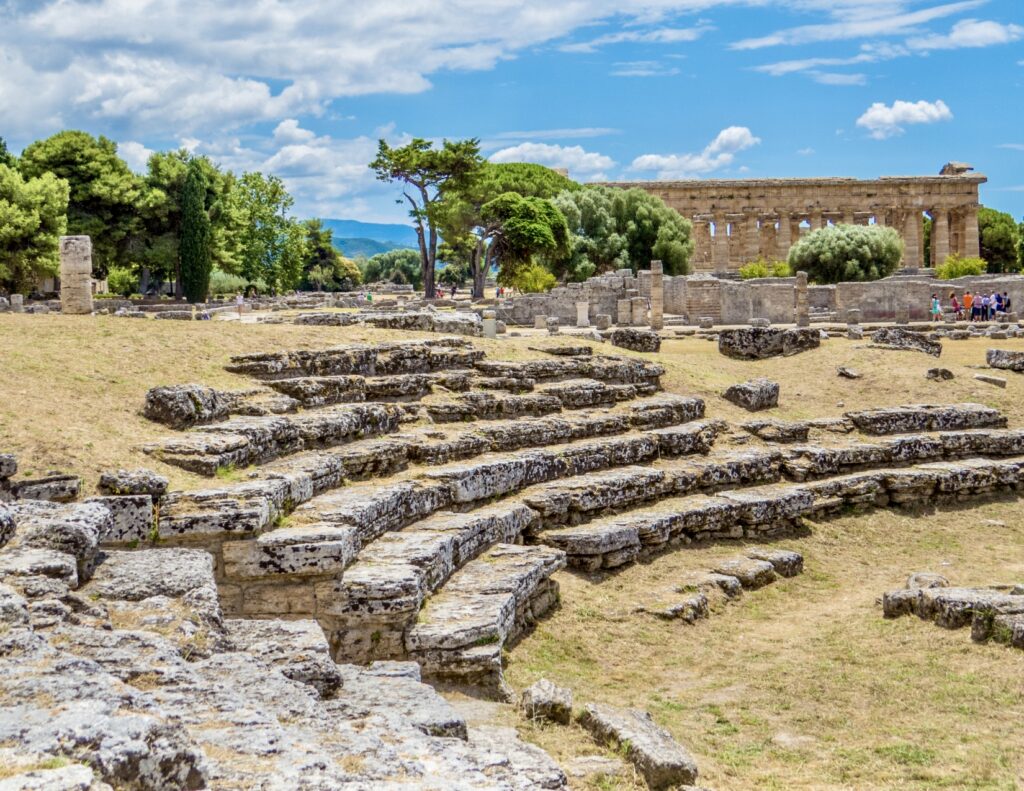
5. Amphitheatre
The Pastum amphitheater dates from the 1st to 2nd century AD. Only the western half has been excavated and is visible today.
This arena, like other Roman arenas, was used for circus shows and gladiatorial games.
The tunnel that led to the theater is still intact. It would have been used for transporting animals and props to the arena floor.
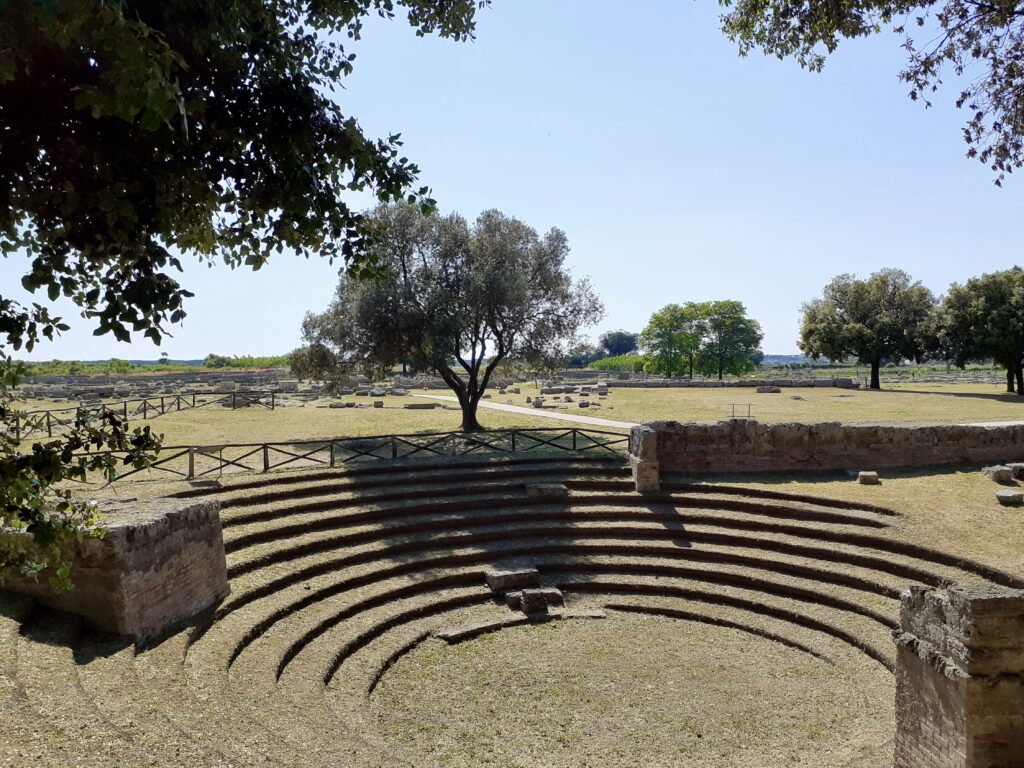
6. Ekklesiasterion
The Ekklesiasterion is oldest building in the agora, dating back to 480-470 B.C. It’s not terribly well preserved, but still offer insights into the democratic practices and civic life of the city.
The Ekklesiasterion was the citizens’ assembly hall and used for public meetings. The term ekklesia referred to the assembly of male citizens who participated in the democratic governance of the city-state.
The structure was circular in shape and had tiered seating in concentric rings. It was designed to provide clear visibility and audibility to all participants, ensuring that debates and discussions could be conducted effectively.
It was used until at least the 3rd century.
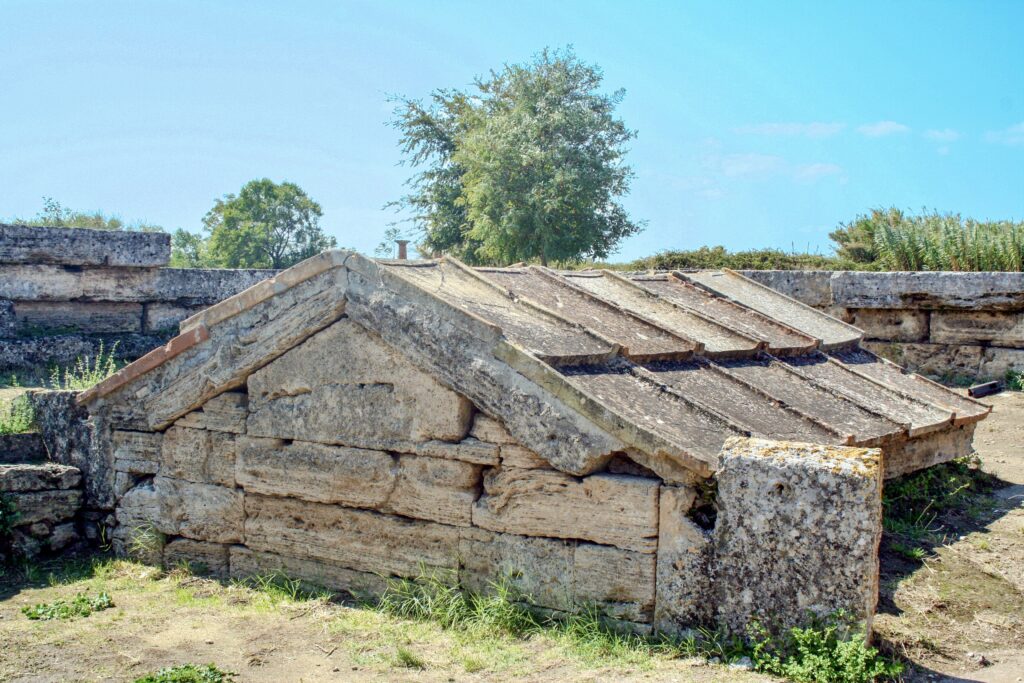
7. Heroon
The heroon from 520 BC is located near the forum and adjacent to the Temple of Athena. A heroon is a chamber that was partially carved into the bedrock.
It’s believed to have been built to honor the city’s legendary founder, even though it was constructed around a century after his passing. This commemorative structure took the form of a simple tumulus, encircled by a protective wall made of large stones.
During its excavation in 1954, a fascinating discovery came to light at its core: a stone chamber with a pitched roof. This chamber was positioned partly below the ground level and partly above it.
Inside this chamber, a remarkable array of finds was unearthed. The included several unusual bronze vessels and an Athenian pottery black-figure amphora from 520–500 BC. Today, these artifacts are in the museum.
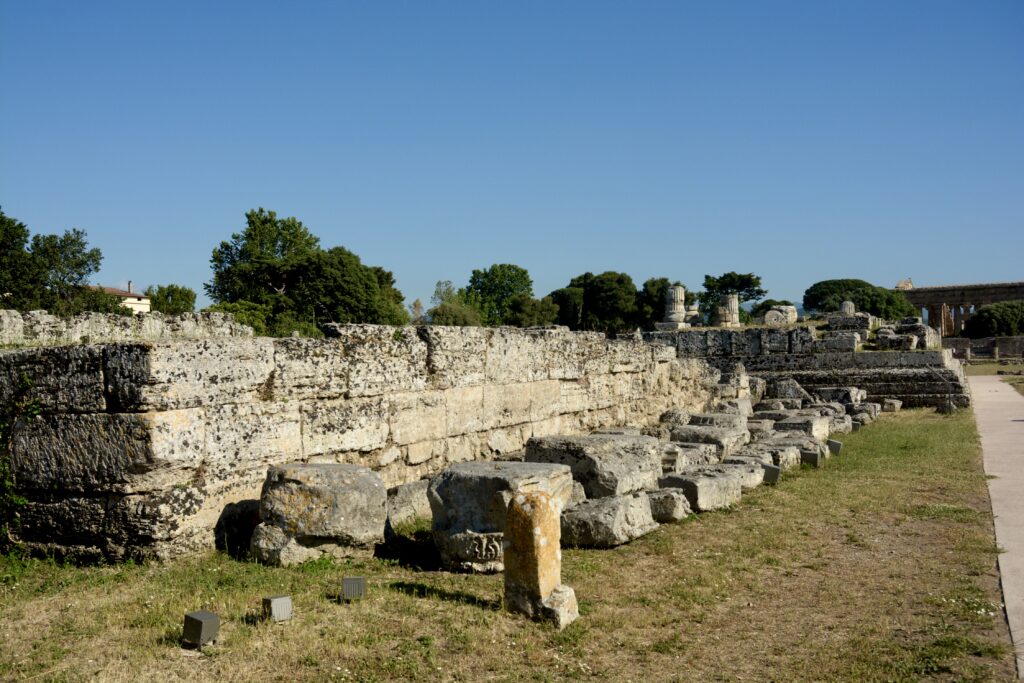
8. City Walls
The city walls of Paestum are some of the best preserved from Magna Graecia. Their building and layout took place over a period from the 6th to the 1st century BC.
Built of blocks of limestone, the walls are no longer their original height.
There were once 28 towers around the perimeter. Two of them were restored in the 20th century.
There are four gates to the city. At the Porta Marina, you can climb the walls and have excellent views of the ruins and the coast.
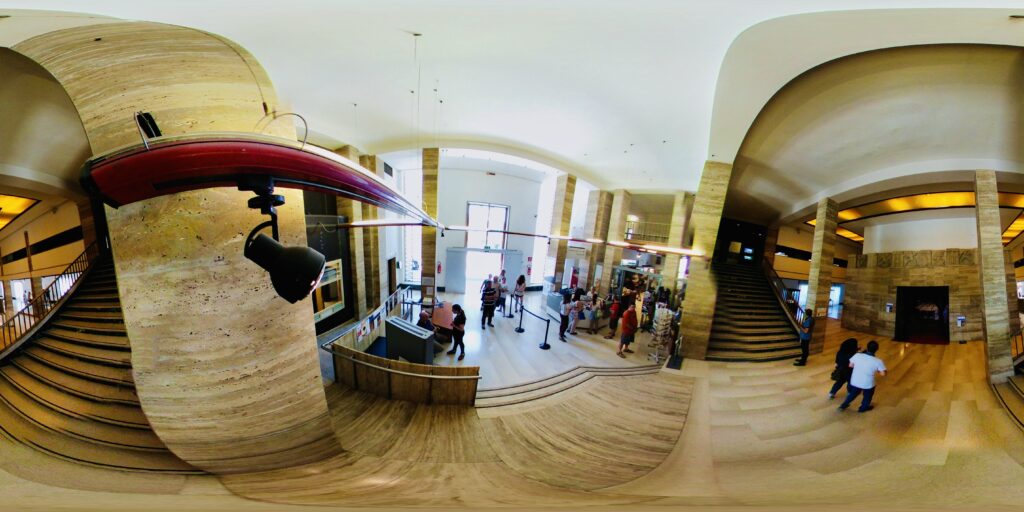
9. National Archaeological Museum Of Paestum
The Paestum Archaeological Museum is a must visit! Opened in 1952, it’s near the entrance to the site and you may want to visit this first to get a sense of what the temples once held.
This modern museum houses archaeological finds from centuries of excavation at the Paestum site. There are sections on Paestum’s prehistory, the Lucanian civilization, Greek Paestum, and Roman Paestum.
You’ll find Greek statues, terracotta pieces, Neolithic, Bronze, and Iron Age pottery, coins, jewelry, and tomb paintings.
Of particular note is a frieze from the nearby Sanctuary of Hera. The decorative panels includes mythological scenes that would have delighted a 6th century B.C. audience.
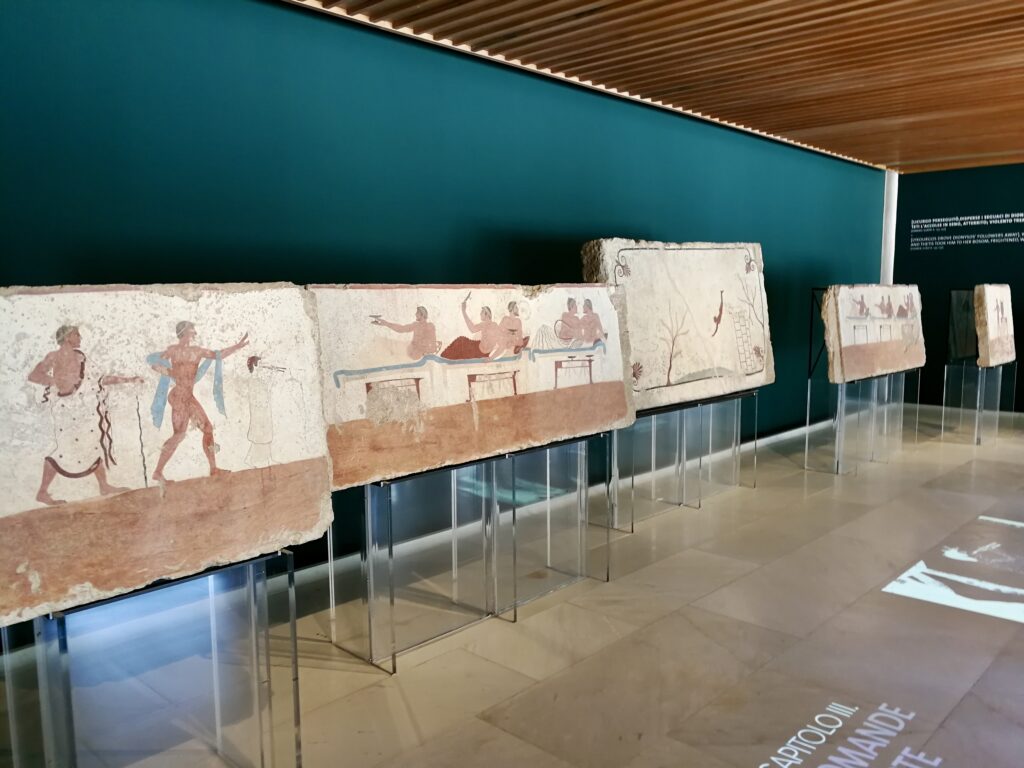
One is a comical story of Hercules and the Kerkopes. Hercules was asleep when two scamps stole his weapons.
He tied them to his pole and carried them over his shoulder. When they laughed at his hairy back, Hercules was amused and decided to let them go.
Other things to see include:
- a bronze vase from the Heroon
- a krater vase portraying the rape of Europa
- flower women votives from the temples
- painted Lucanian tombs
- dancing girl metopes from the Temple of Hera
- a 1st century portrait bust of Tiberius
- an Aphrodite vase
- red figure vases
- statuettes of Venus
- artifacts from the necropolis of Gaudo
READ: Guide To The Naples National Archaeological Museum
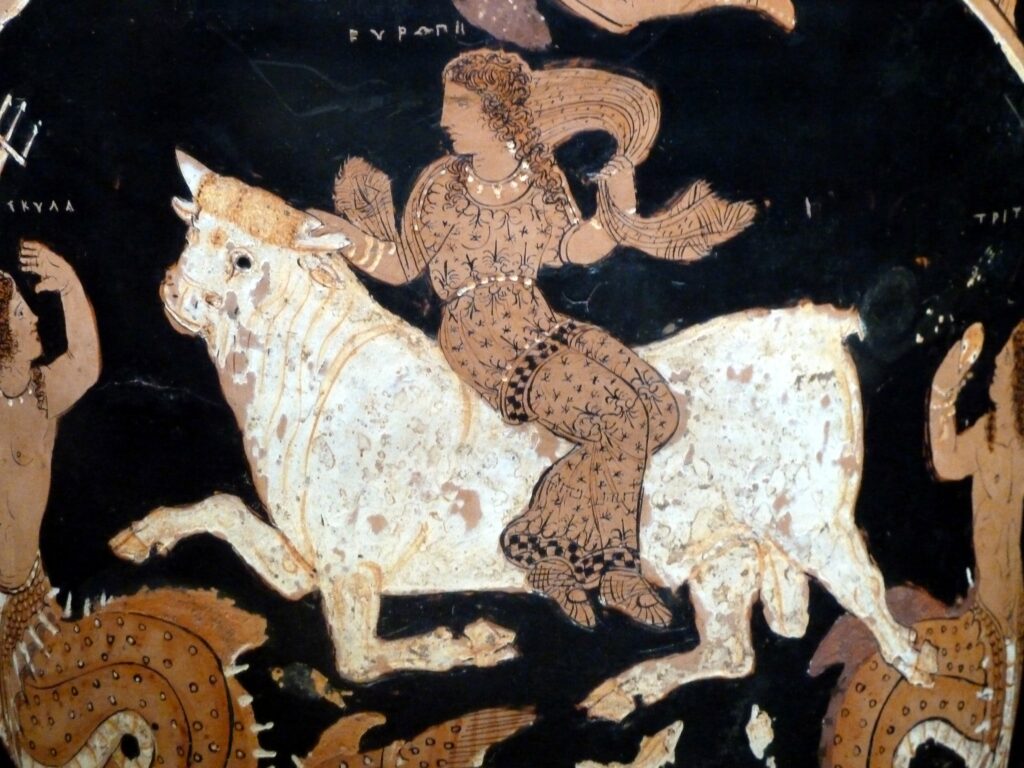
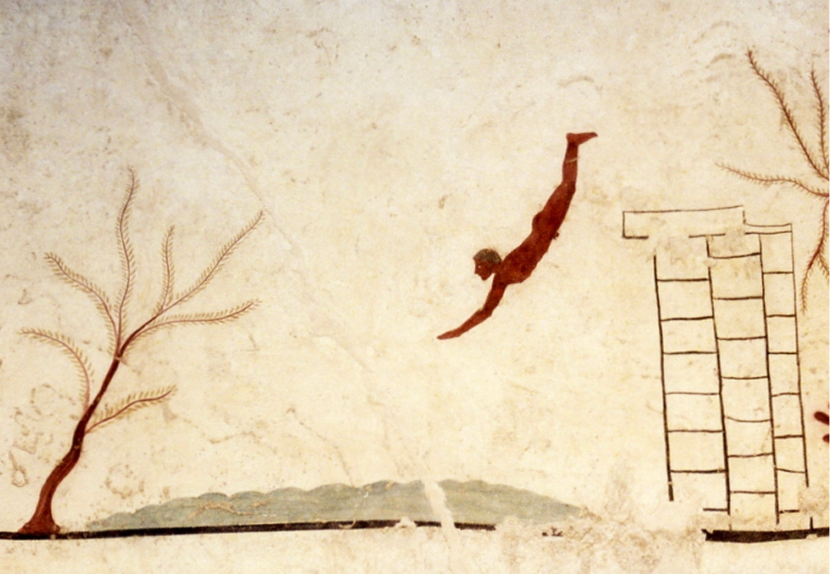
10. Tomb of the Diver
The star of the museum is the Tomb of the Diver, an ode to eternity. In 1969, a farmer in the area discovered the only known ancient Greek frescoes from a tomb dating from 470 BC. It was an extraordinary archaeological find.
There is some debate about whether it was created by the Greeks or the Lucanians. But most historians believe it was the indigenous Lucanian inhabitants of the region.
Crafted from five limestone slabs, this enigmatic tomb features four walls forming its enclosure and an extraordinary fifth slab that serves as the tomb’s ceiling or roof. It is from this captivating roof that the tomb gets its name.
The image depicts an athletic young man gracefully diving into a stream of water, almost into the unknown.
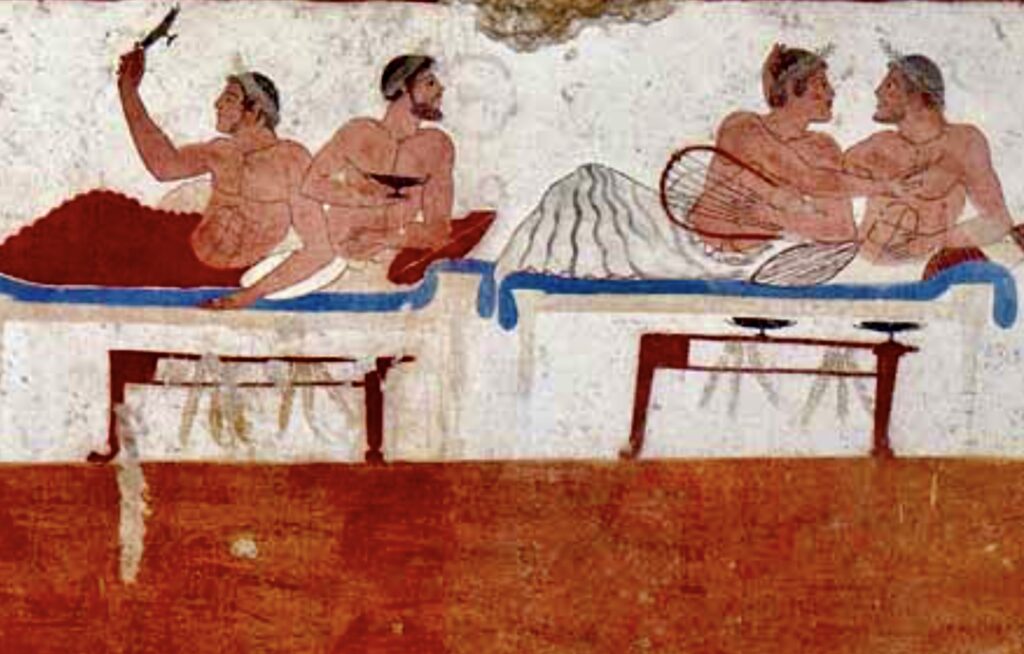
The meaning has long been debated. But it’s most likely a symbol of passing into the afterlife. Is there a new world of life beneath the water?
Inside the tomb, four walls are adorned with buon fresco paintings — true frescos rapidly painted on wet plaster.
They capture scenes of a lively symposium – basically a Greek drinking party. They are most likely giving the diver a good send off.
There are some homosexual scenes. In one of the longer panels, two lovers are on the right. Another two men sit on a couch watching them.
These paintings are unique and very significant because they represent the only known surviving ancient Greek frescoes with figurative imagery from this period.
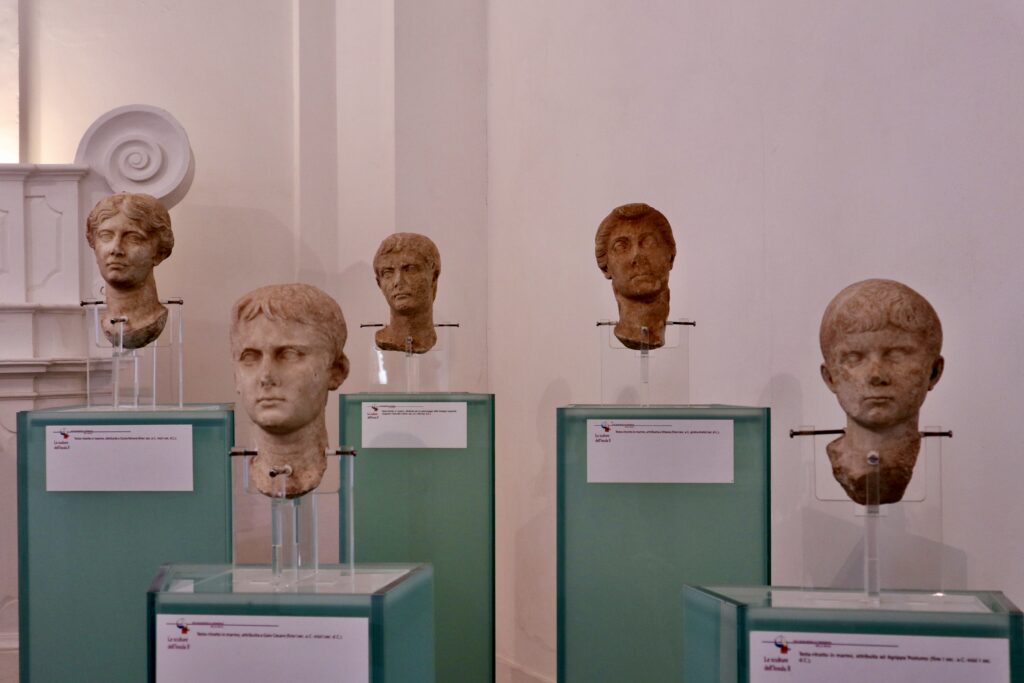
Guide To Paestum: Tips For Visiting
No guide to Paestum is complete with some must know tips for visiting the site and museum.
1. Where Is Paestum
Paestum is located in the Campania region of southern Italy. It’s situated on the Tyrrhenian Sea coast, in the province of Salerno. The town is considered to be the “capital” of the Cilento region.
Paestum is about 55 miles from Naples and 3 hours from Bari in Puglia.
Paestum is relatively close to the Amalfi Coast too, making it a feasible day trip destination from the coastal towns. Here are the times:
- Amalfi Town to Paestum: Approximately 35 miles via car, taking around 1.5 to 2 hours
- Positano to Paestum: Approximately 40 miles via car, taking around 2 hours
- Sorrento to Paestum: Approximately 56 miles via car, taking around 2 to 2.5 hours
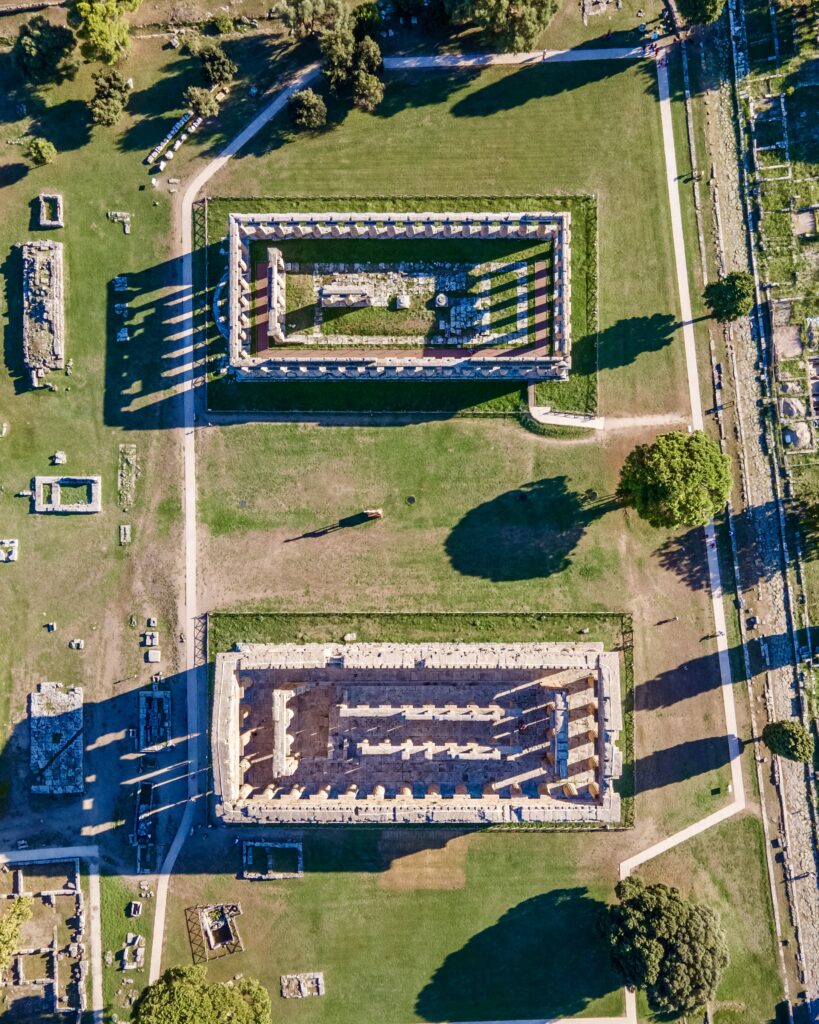
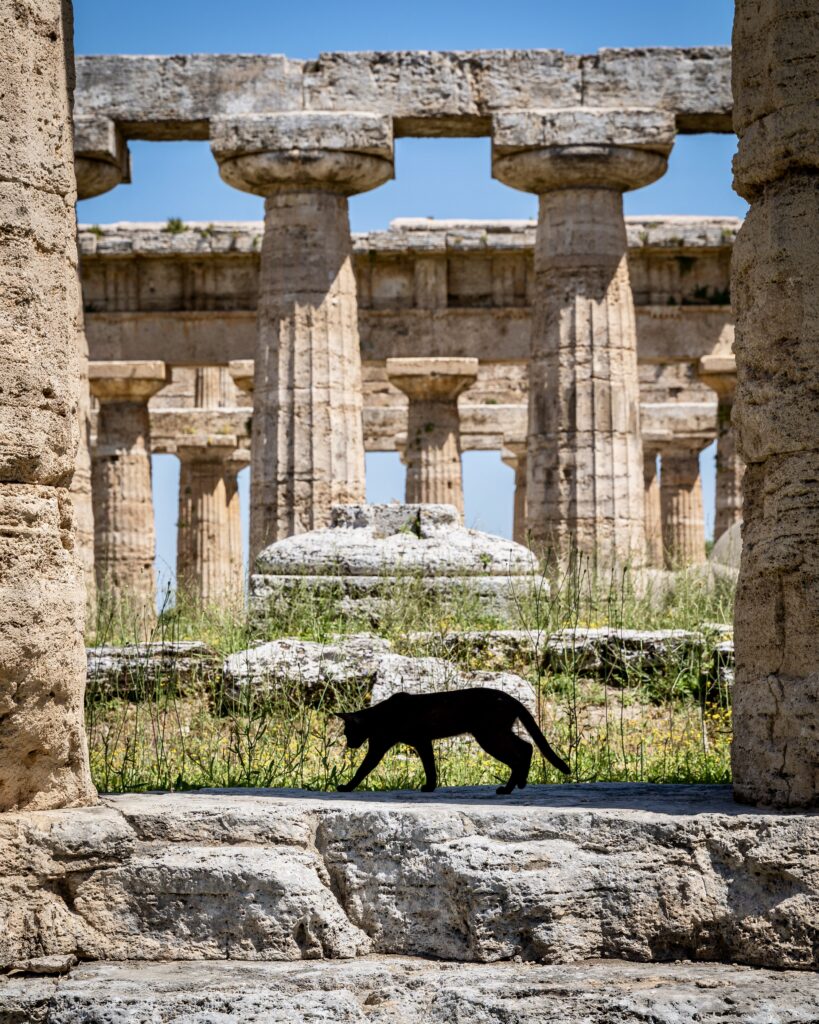
2. How To Get To Paestum
If you’re driving, follow the S18 south of Salerno. At Paestum, there are designated parking areas available for visitors.
The main parking lot is near the entrance to the archaeological site, making it easily accessible. Additionally, there are often parking spaces available along the roads leading to the site.
You should plan to arrive arrive early, especially during peak tourist seasons, to secure a parking spot.
If you are planning to take the train from Naples, you must book a regional one from Napoli Centrale. There are two train stations in Paestum: Paestum Station (Stazione di Paestum) and Capaccio-Roccadaspide Station (Stazione di Capaccio-Roccadaspide).
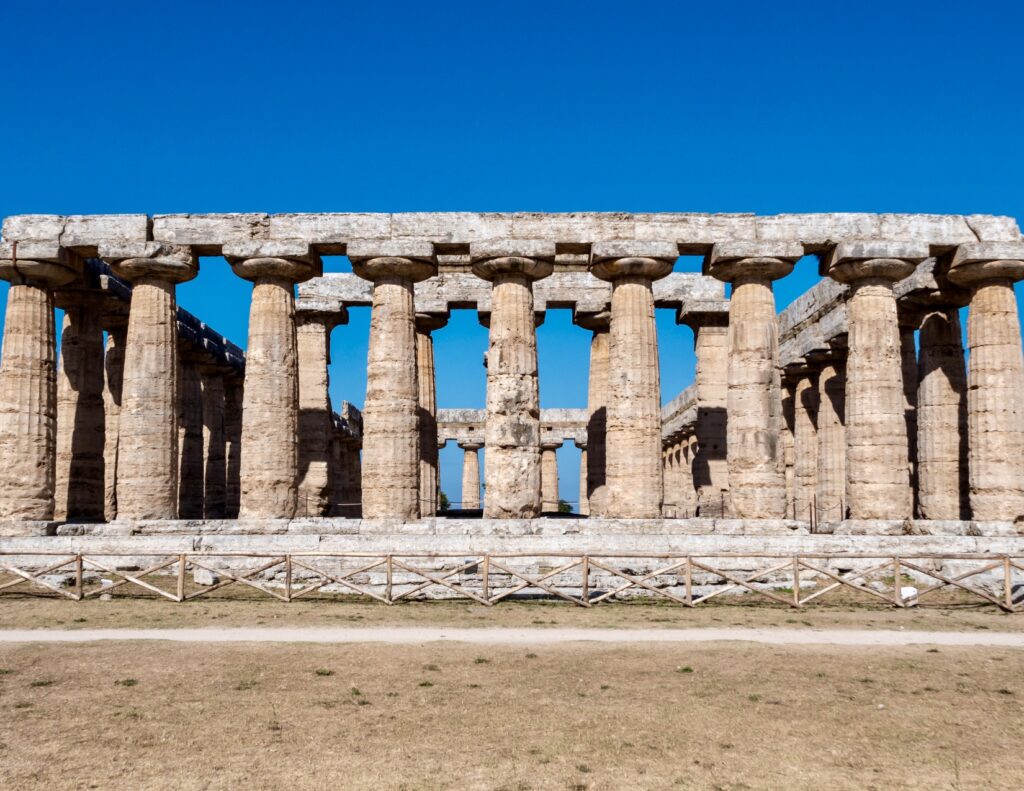
You can check times and book tickets on Trenitalia. Either station is about a 10-15 minute walk to the ruins. The Paestum one is a bit closer.
You also book a train ticket and skip the line ticket for the archaeological site here. You can also book a private transfer to Paestum from the Naples station.
If you would prefer to visit Paestum on a guided tour, that’s an efficient way to visit. Here are some options:
3. How To Get Around Paestum
You can just walk around Paestum. The site is designed to be pedestrian-friendly.
Well-maintained paths lead you through the different areas of the ancient city. They’re a tad uneven, so wear comfortable shoes.
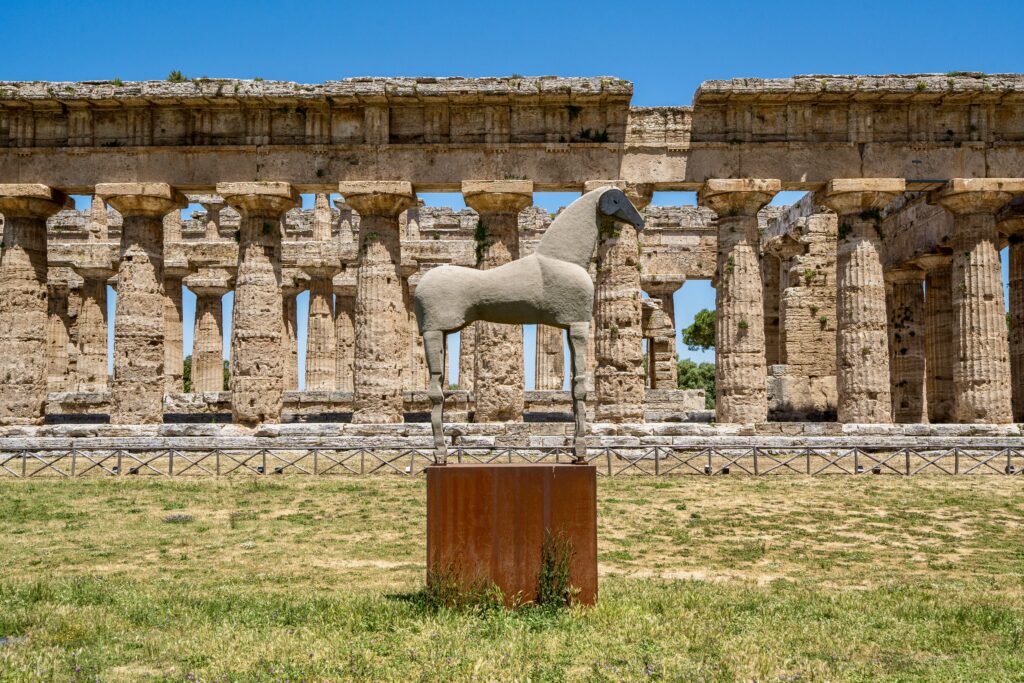
4. When To Visit Paestum
I think the best time to visit Paestum is the spring or fall. It’s less busy then than in the summer. And the scene is especially picturesque with poppies and wildflowers surrounding the ruins.
5. How Long To Spend At Paestum
Most visitors spend about 2-3 hours in Paestum. I would plan to spend at least an hour or so visiting the temples and another hour at the museum. If you have a particular interest in archaeology, perhaps more.
6. Where To Stay in Paestum
Naples makes a good base to explore Paestum. For more information on where to stay, you can check out my 3 days in Naples itinerary.
On the Amalfi Coast, the lovely Palazzo Belmonte has a private beach and is just a 30 minute drive from Paestum.
If you want something close to Paestum, you can check out the Hotel Cerere, Mec Paestum Hotel, and Hotel dei Templi.
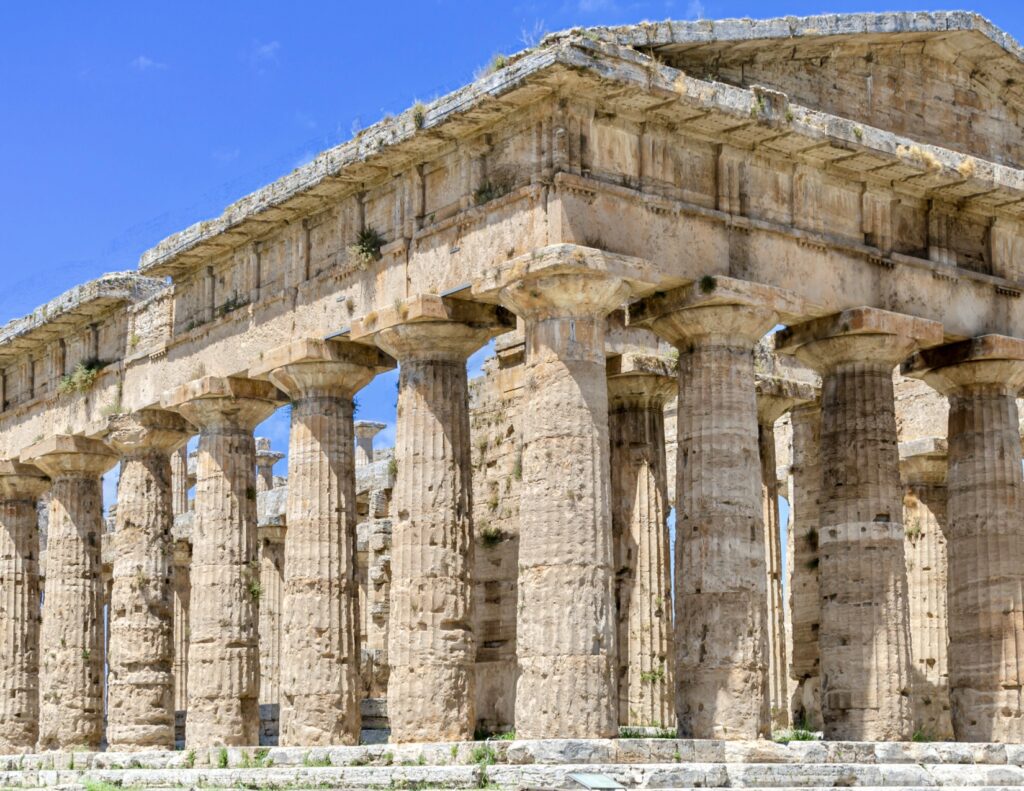
7. Is Paestum Worth Visiting?
If you are a Greek history buff or love archaeological sites (I do!), Paestum is 100% worth visiting. Paestum boasts some of the best preserved Greek ruins in the world, and certainly the best on mainland Italy.
The two things that struck me about Paestum were: (1) the incredible state of preservation of the ruins; and (2) the fact that you could walk inside them. This made the visit super enjoyable for me.
If ruins aren’t your thing, maybe you can skip Paestum. And the downside of visiting the town is that it’s a bit isolated from other attractions.
7. Other Practical Information
Address: Via Magna Grecia 913
Hours: Open 8:45 am until one hour before sunset. Last admission 2 hours before sunset.
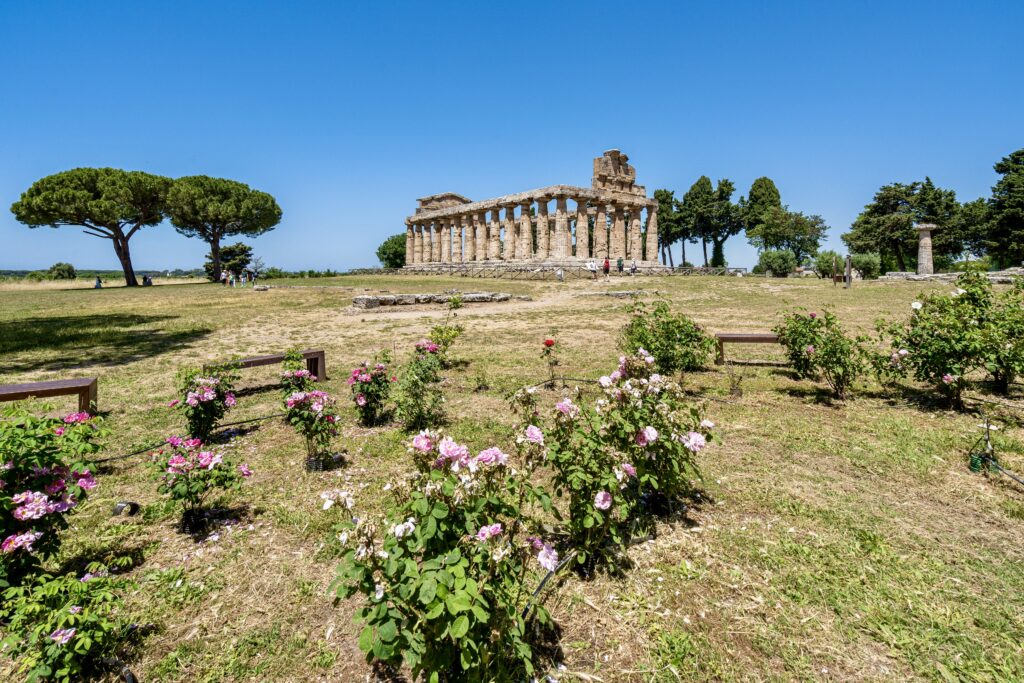
Tickets:
Tickest are 12 euros. In December through February, they are 6 euros.
Click here to pre-book a ticket. You can also visit Paestum with the Artecard. It comes in several versions and offers free entry to many of Campagnia’s attractions.
I hope you’ve enjoyed my guide to Paestum. You may find these other southern Italy travel guides useful:
- 10 Days in Southern Italy Itinerary
- One Week In Puglia Itinerary
- Places To Visit in Puglia
- One Week Amalfi Coast Itinerary
- One Week Rome & Amalfi Itinerary
- 5 Days on the Amalfi Coast
- One Day In Naples Itinerary
- 3 Days In Naples Itinerary
- 2 Days in Matera Itinerary
- 2 Days In Ravello itinerary
- 2 Days In Capri itinerary
- Ultimate Guide To Pompeii
If you need a guide to Paestum, pin it for later.

